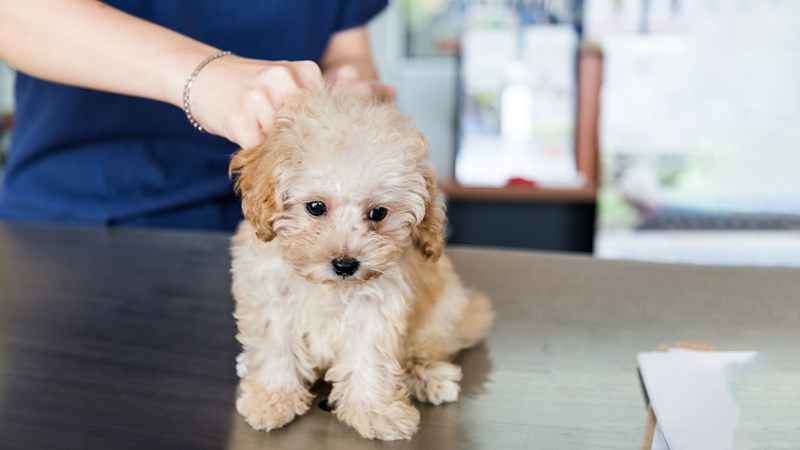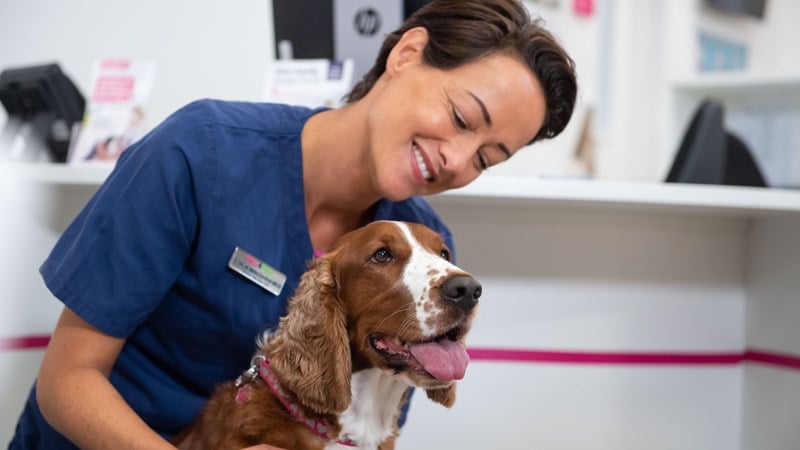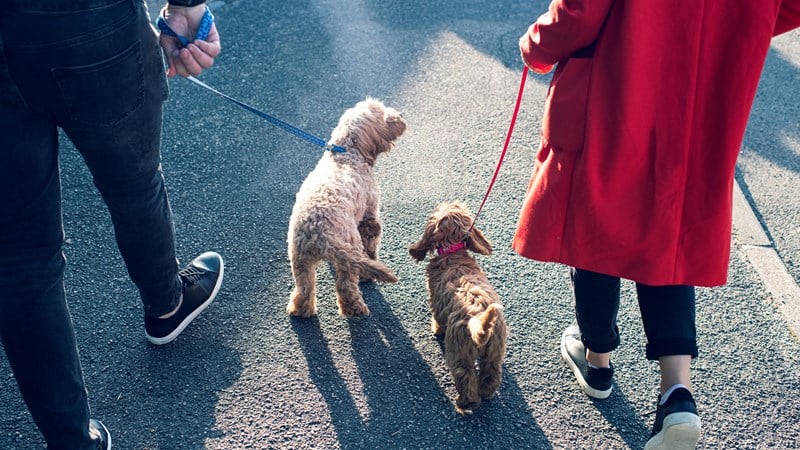
How To Help Puppies Who Have Missed Out On Socialisation In Lockdown
If you’re about to become the proud owner of a new puppy, or if perhaps you’ve welcomed one into the family during lockdown, you’ll already know you’re going to be busy! But did you know that you’ll also need to try extra hard when it comes to their socialisation?
During their early development, baby animals go through a phase in which their experiences have a big impact on how they are likely to view the world around them as they grow up. At this time, they’re learning what is safe and what is to be avoided – we call this process ‘socialisation’. The phase of a baby animal’s life where this normally happens is called the socialisation period, or socialisation window.
In puppies, the socialisation period begins at birth and is mostly over by 16 weeks, however, the main socialisation period for most puppies is from about three weeks to 12 weeks.
How does puppy socialisation usually work?
Normally, by the time you collect your puppy, reputable breeders will have begun socialising the litter by handling them, letting them see all sorts of people of different ages and appearances, including children, and introducing them to other animal species.
The puppies might also have been lucky enough to have seen other breeds of dog in the breeder’s household, and they might have taken some short car journeys. By being brought up in the home, puppies should be used to the sights and sounds of household appliances, such as the TV, washing machines and vacuum cleaners.
How can you help with puppy socialisation during lockdown?
If you brought home your puppy before or during lockdown, you might have been doing everything you can to socialise them while staying at home and within your own garden. You might now have a puppy of four or five months old who knows all about the tumble dryer and is used to loud noises coming from the TV, but who has never met a child, or someone riding a bike or carrying a walking stick.
Without this important exposure to a wide range of early experiences, many dogs – and there is some variation, depending on an individual dog’s temperament – are fearful when they do encounter these things later on. Often, people think dogs must have had something bad happen to make them fearful, when, in fact, it could just be that the dog had no prior experience and has immediately decided that the new experience is scary.
When you do start to venture out with a youngster who’s had incomplete socialisation, they’re likely to find it all a bit worrying and may bark at people, other dogs, or moving vehicles, which is no fun at all for either of you!
Depending on what you and the breeder have been able to manage so far, and on the age of your pet when you collect them, it’s likely that you’ll need to work that bit harder on socialisation to help them to cope with the world around them.
Although they may always have moments of uncertainty in particular situations, the good news is that, with patience and understanding, you can help your puppy to catch up and to grow into a happy, confident dog. Read on for some tips...
How can you help with puppy socialisation during lockdown?
Although the socialisation window may already have closed, the process isn’t a race.
Taking the time to allow your puppy to become comfortable with particular situations or experiences will help to ensure that those things (or people!) really have gone from the puppy’s ‘scary’ list to their ‘trusted’ list.
Socialisation doesn’t have to mean formal or forced introductions to new sights and sounds. In fact, sometimes, placing your puppy right into the thick of things can overwhelm them and turn what might have been a positive experience into a negative one. As you explore the world together, the idea is for your puppy to feel comfortable with each new thing, but not necessarily interact with it. This can mean that, especially to begin with, the puppy doesn’t need to be very close to the experience in question.
Let’s take traffic as an example... Your puppy might not have seen cars or motorbikes yet. When it’s time to start going out (in your arms, until vaccinations have been completed, or wearing a properly fitted harness), choose a place to watch vehicles passing where you’re at least 20m away to begin with. Chat to your puppy and be ready to jolly them along if they look worried or seem to flinch or get excitable when a vehicle passes. Have treats and reward your puppy when they look calmly to you for guidance.
Once you’re sure your puppy isn’t finding passing traffic interesting, you can move on to a different experience and come back to traffic the following day, but gradually move closer.
This process is called desensitisation and it just means that we are encouraging the puppy to become less bothered by the world around them.
You may have seen lists of experiences to tick off as your puppy tries and becomes comfortable with them. You can find a great list here that includes lots of different, everyday experiences for you to use as a guide and record your puppy’s reactions. Remember, you don’t have to hurry through lists like this, but they can help to remind us just how many things we expect our dogs to cope with during our lives together!
Your puppy might find some new sights and sounds more difficult to cope with than others. Recent and current social distancing guidelines may mean that certain situations, such as meeting a wide variety of people and animals, especially other dogs, might be more challenging to progress with than others.
Remember, take things as slowly as you need to and always keep within current guidelines regarding social distancing. You can still make progress and, as long as you go at your puppy’s pace, you can work on being closer to unknown dogs and people later on.
If your puppy does get upset and begins to bark or lunge, try not to get cross with them.
It’s only natural to show other people that you don’t approve of your dog behaving like this towards them, but it will only make your dog more worried if you tell them off for showing that they’re uncomfortable with something.
Instead, reach for a valuable reward, or even better still, have that ready when you know you’ll be passing someone or something that your dog isn’t yet happy about, and distract your puppy while keeping on moving.
Once they’re behaving calmly again, give them a cheerful ‘Well done!’ and another reward for calm walking.
It’s a great idea to find out what your puppy considers a reward. Not all pups are motivated by food – some prefer toys – and not all toys were created equally! By taking out a variety of small-bite food rewards and toys, you’ll be able to reward your pup for calm reactions to new sights and sounds and distract them with a game if you spot any signs they are getting worried or fixated on a particular experience.
For puppies who are motivated by food, you can chop up tiny pieces (no bigger than the fingernail on your little finger) of mild cheddar or cooked chicken. You can use some of the puppy’s allocated daily food ration for puppies who think anything edible is marvellous.
A trip to your local Pets at Home store should give you plenty of choice – there are edible treats that are specially designed for puppies, and you can have a look at all the toys. Some puppies love tuggy-toys (keep any tugging really gentle to protect little necks and teeth); others think squeaky toys are the best thing ever! If you find squeakers a bit much, you can even get ones that oink gently and still please puppies just as much!
When you’re doing any kind of training, including desensitisation training and socialisation, it’s good to take along rewards of different value to the puppy, just in case you need something really special to reward a particularly calm reaction to something, or in case you need a powerful distraction to something unexpected or that particularly worries your puppy.
You’ll want to keep ‘average’ value rewards for most of the training, or some puppies become so excited by the reward that they forget to pay any attention to what they’re supposed to be learning about!
You can make a positive difference to your puppy's wellbeing by keeping in mind that socialisation is an ongoing project for the first year of their life, so think about opportunities to continue their education even when they’re growing through adolescence and into an adult dog.
If you’re struggling with socialising your puppy, remember, you aren’t alone. Your vet practice team have your puppy's mental as well as physical wellbeing at heart. They can offer support and if you need help from a qualified veterinary behaviourist or trusted dog trainer, they can help you to get in touch with one.
Know the signs of a worried – or happy – pup
When you’re out exploring together, it’s important to recognise whether your puppy is calm and happy, or whether they’re getting anxious about something, so that you how they’re coping with the situation and can react appropriately.
Signs to look out for
- Relaxed body posture – sitting or lying down, often with hind feet out to the side.
- Tail wagging gently or held in a soft position, either dangling loosely behind them or held slightly raised and curved in a wag.
- Head either straight or slightly tilted, with a relaxed neck so they can observe an object of interest and look back at you for guidance.
- Eyes opened normally, or partially closed, with medium sized pupils and not fixed on any one thing. Able to look you comfortably in the eye for short periods. (Staring dogs in the eye is threatening to them, so don’t stare back into your puppy’s eyes when they’re looking at you for guidance).
- Ears relaxed, folded down or back; or relaxed and moving around (in dogs whose ears stand up). When exploring or sniffing something interesting, ears may be directed forwards.
- Mouth either closed, or open with gentle panting with the tongue out or often back behind the lower incisors. The corners of the mouth relaxed and ‘smiling’.
Although this body language is just a guide, usually, you’ll get an idea of your puppy’s mood by observing their general appearance and looking for relaxed movements.
Usually, the body language will be much stiffer and more measured, presenting a general picture of a tense dog, who’s ready to run or defend themselves, for instance...
- Body posture much more likely to be standing (although some worried dogs lie on their backs or flatten themselves when they perceive a threat).
- Tail may be stiff, with no wagging, held either between the hind legs or straight out behind them.
- Head may be held stiffly in a position directed towards whatever has worried them. Occasionally, they may hold their heads straight but follow a threat with their eyes.
- Eyes are much more likely to be opened wider, sometimes enough for you to see little crescents of the whites of their eyes. Pupils will often be enlarged and the eyes are much more likely to stare.
- Ears may be directed forwards, but sometimes, in dogs who can move their ears quite freely, they are sometimes held tightly back. Whichever position they’re in, they’re more likely to be stiffened and still.
- The mouth may be held tightly closed, or the lips may twitch or be lifted at the front to show the canine teeth. Worried dogs often yawn, lick their lips and gulp, or stick their tongue a short way out of their mouth while displaying their front teeth and canines.
- Worried dogs often vocalise – anything from a low, rumbling growl, to a full-on alarm bark.
Puppy Podcast

Health Plans to keep your puppy healthy
At Vets4Pets we offer a range of Health Plans that make essential routine treatments more affordable. You'll save money on things like annual vaccinations, flea and worm treatment and routine health check-ups.

Join our free VIP Puppy club
Join the club for expert advice and tailored offers, including £30 off our Complete Care Health Plans

Puppy & Kitten Advice
Giving your pet the best start in life begins with getting the best expert advice.
